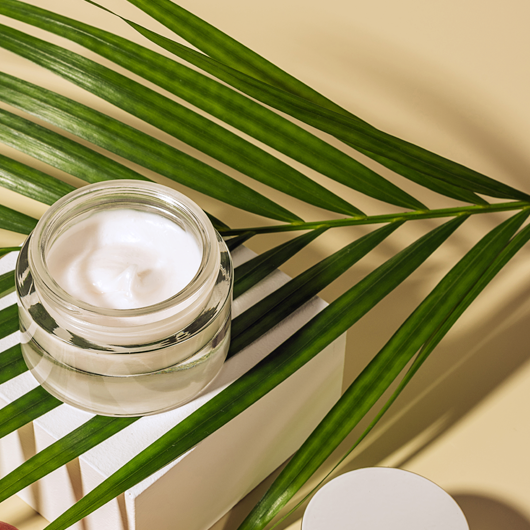If you've ever looked into the best peptides for anti aging, you've probably come across big names like Matrixyl and Argireline. These aren't just buzzwords; they're powerhouse ingredients known for their incredible ability to support the skin's youthful appearance. They work by sending messages to your skin cells, telling them to maintain those crucial proteins that keep everything looking smooth and firm.
What Are Peptides and How Do They Work
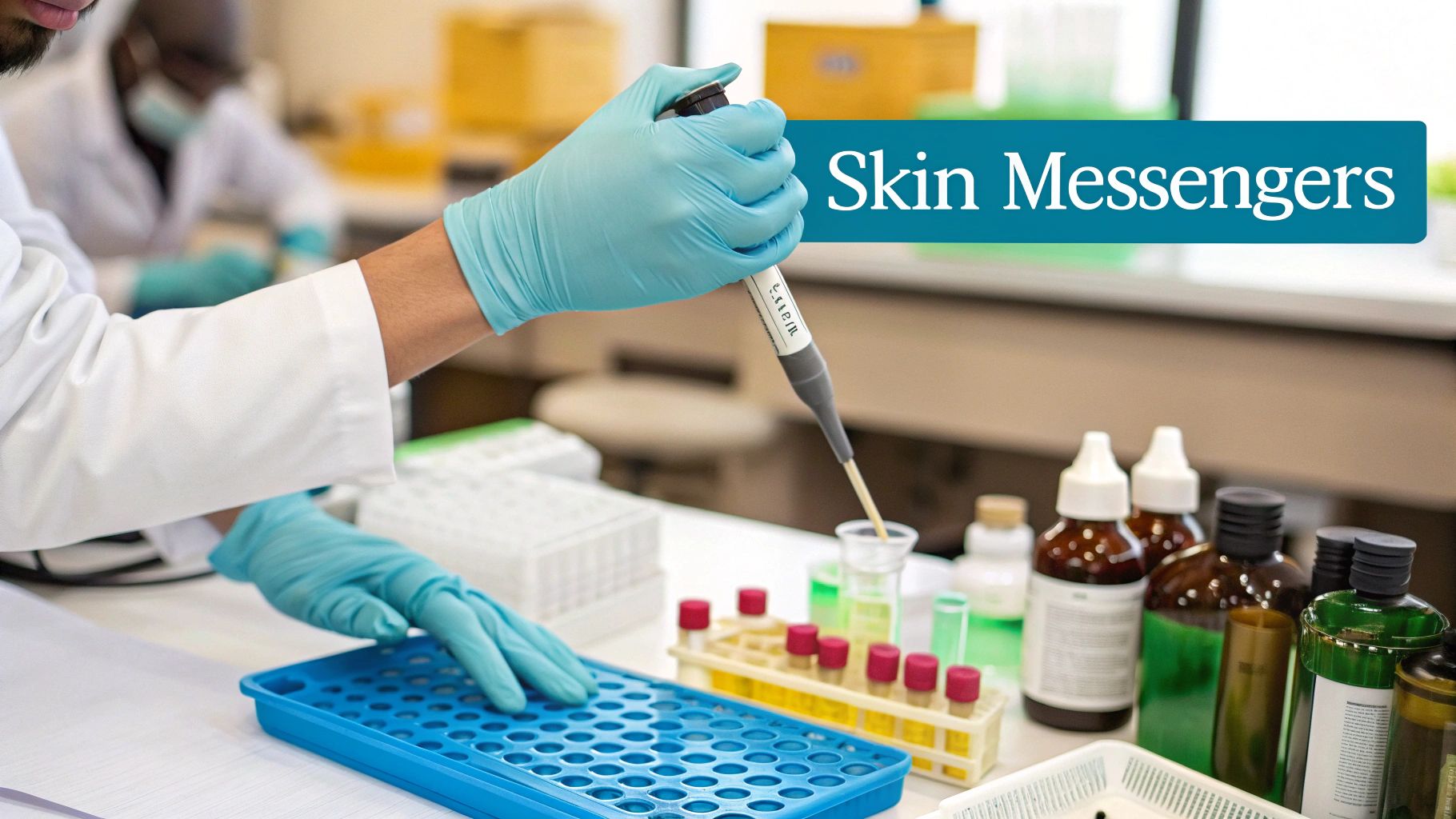
Think of your skin's foundation as a well-built brick wall. The bricks in this wall are proteins—specifically, collagen and elastin, which give your skin its structure and bounce. So, where do peptides fit in? They're the skilled construction crew, the little messengers who keep the whole operation running smoothly.
Peptides are simply short chains of amino acids, which are the fundamental building blocks of those vital proteins. They’re what your skin uses to create more collagen and elastin.
As we get older, our body's natural production of these "workers" starts to slow way down. Fewer new "bricks" get laid, and the existing wall starts to show some wear and tear. You see this as fine lines, wrinkles, and a general loss of firmness. That’s where a good topical peptide comes in.
When you apply a peptide serum or cream, these tiny communicators get to work. They signal your skin cells, essentially giving them a nudge to keep up with their natural functions. By supporting your skin’s own processes, peptides help preserve that smooth texture and resilient structure we all want.
The Science Behind Skin Appearance
Here's the cool part: peptides aren't a one-trick pony. Different peptides have different jobs. Some are laser-focused on encouraging collagen, while others are all about maintaining elastin. It’s this incredible specificity that has made them a true cornerstone of modern, effective skincare.
By mimicking the body's natural communication signals, peptides offer a way to support the skin's existing architecture. They essentially remind the skin how to maintain its youthful look, promoting a visibly smoother and more resilient complexion over time.
And people are noticing. The demand for high-performance skincare is absolutely booming, showing a clear shift towards ingredients with a proven purpose. The U.S. anti-aging products market was valued at an incredible USD 14.05 billion recently and is only expected to grow. It’s no surprise that consumers are actively seeking out products with potent, science-backed ingredients like peptides.
The Different Types of Skincare Peptides
Diving into the world of peptides can feel a bit like learning a new language. They're all short chains of amino acids, but they definitely don't all have the same job. Figuring out their different roles is the secret to finding the best peptides for anti aging that actually match up with what you want for your skin.
Let's try an analogy. If your skin is a major construction project, you can't just have one type of worker. You need architects to draw up the blueprints, foremen to shout out orders, and delivery drivers to haul in the essential supplies. Skincare peptides work in a very similar way, each falling into a distinct category based on what they do.
This infographic gives a great visual breakdown of the main peptide players and their roles in keeping skin looking youthful.
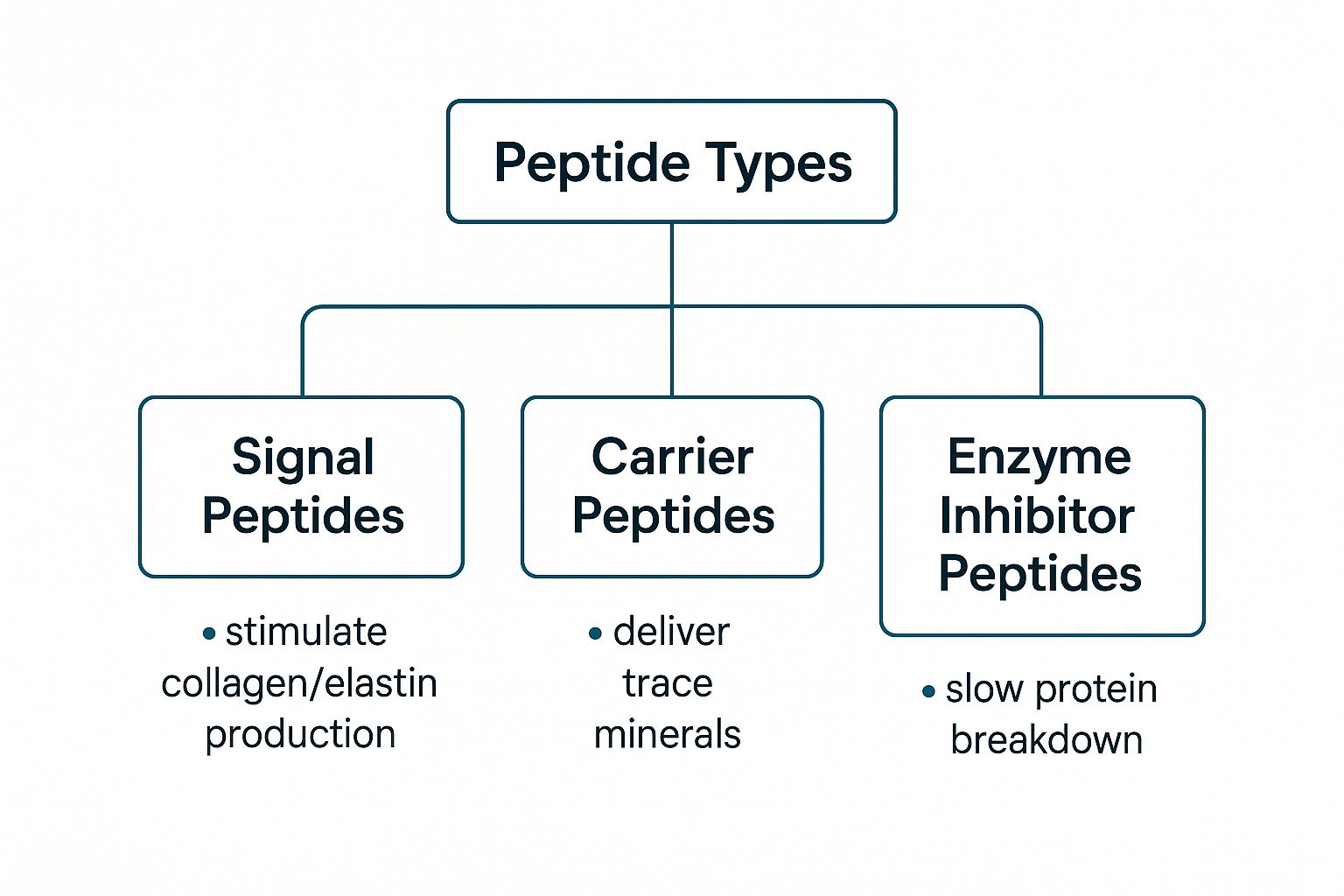
As you can see, each type of peptide has a very specific mission, whether it’s kickstarting protein production or delivering crucial minerals right where your skin needs them. Let’s get to know these specialists a little better.
Signal Peptides: The Messengers
Signal peptides are probably the ones you've heard about most in anti-aging skincare. Think of them as tiny messengers that send signals to your skin cells, encouraging them to get busy producing important proteins like collagen and elastin. When you have plenty of these proteins, your skin keeps its firm, smooth appearance.
As we get older, our skin's natural signaling system starts to slow down. That's where signal peptides come in. They give your skin a gentle nudge, supporting its own processes to maintain structure and resilience. Famous examples like Matrixyl 3000 (which is actually Palmitoyl Tripeptide-1 and Palmitoyl Tetrapeptide-7) are classic signal peptides.
Carrier Peptides: The Delivery Specialists
Next up, we have the carrier peptides. Their main gig is to transport and stabilize essential trace minerals, like copper and manganese, which are vital for many of your skin's natural enzymatic processes. Copper, in particular, is a well-known powerhouse for maintaining overall skin appearance and radiance.
You can think of carrier peptides as a dedicated chauffeur service for these important minerals. By binding to them, carrier peptides make sure these elements get exactly where they need to go to help your skin's functions run smoothly.
This targeted delivery is what makes them so effective. It helps maintain the skin’s youthful look by ensuring key biological processes have all the components they need to perform at their best. Copper peptides (GHK-Cu) are the most famous example of this group.
Enzyme Inhibitor Peptides: The Guardians
Finally, let's talk about enzyme inhibitor peptides. These work by slowing down the natural breakdown of proteins in your skin. It’s a normal part of aging for our skin to produce enzymes that degrade collagen and other structural proteins over time.
Enzyme inhibitor peptides essentially interfere with this process, helping to preserve your existing proteins for longer. This action helps your skin maintain its firmness and smoother appearance. You'll often find these properties in peptides derived from natural sources like rice or soy proteins.
Understanding these three main categories—the messengers, the delivery specialists, and the guardians—is the first step. It helps you see how different peptides can be combined to create a truly comprehensive and effective approach to your skincare.
To make it even clearer, here’s a simple table that lays out the different peptide types and their primary jobs.
Comparing Different Types of Skincare Peptides
This table breaks down the main categories of peptides used in skincare, their primary functions in supporting youthful-looking skin, and provides common examples.
| Peptide Type | Primary Function in Skincare | Example Peptide |
|---|---|---|
| Signal Peptides | Send messages to skin cells to boost collagen and elastin production, helping to improve firmness and reduce the look of wrinkles. | Matrixyl 3000 (Palmitoyl Tripeptide-1 & Palmitoyl Tetrapeptide-7) |
| Carrier Peptides | Deliver and stabilize essential trace minerals like copper, which are crucial for enzymatic processes that support skin appearance. | Copper Peptides (GHK-Cu) |
| Enzyme Inhibitor Peptides | This process slows down the natural breakdown of collagen and other structural proteins, helping to preserve the skin's existing firmness and elasticity. | Peptides derived from rice or soy proteins. |
By getting familiar with these different peptide functions, you can start to strategically choose products that address your specific skin concerns, whether that's boosting firmness, improving texture, or simply maintaining a healthy, youthful glow.
Top Peptides for a Visibly Youthful Appearance
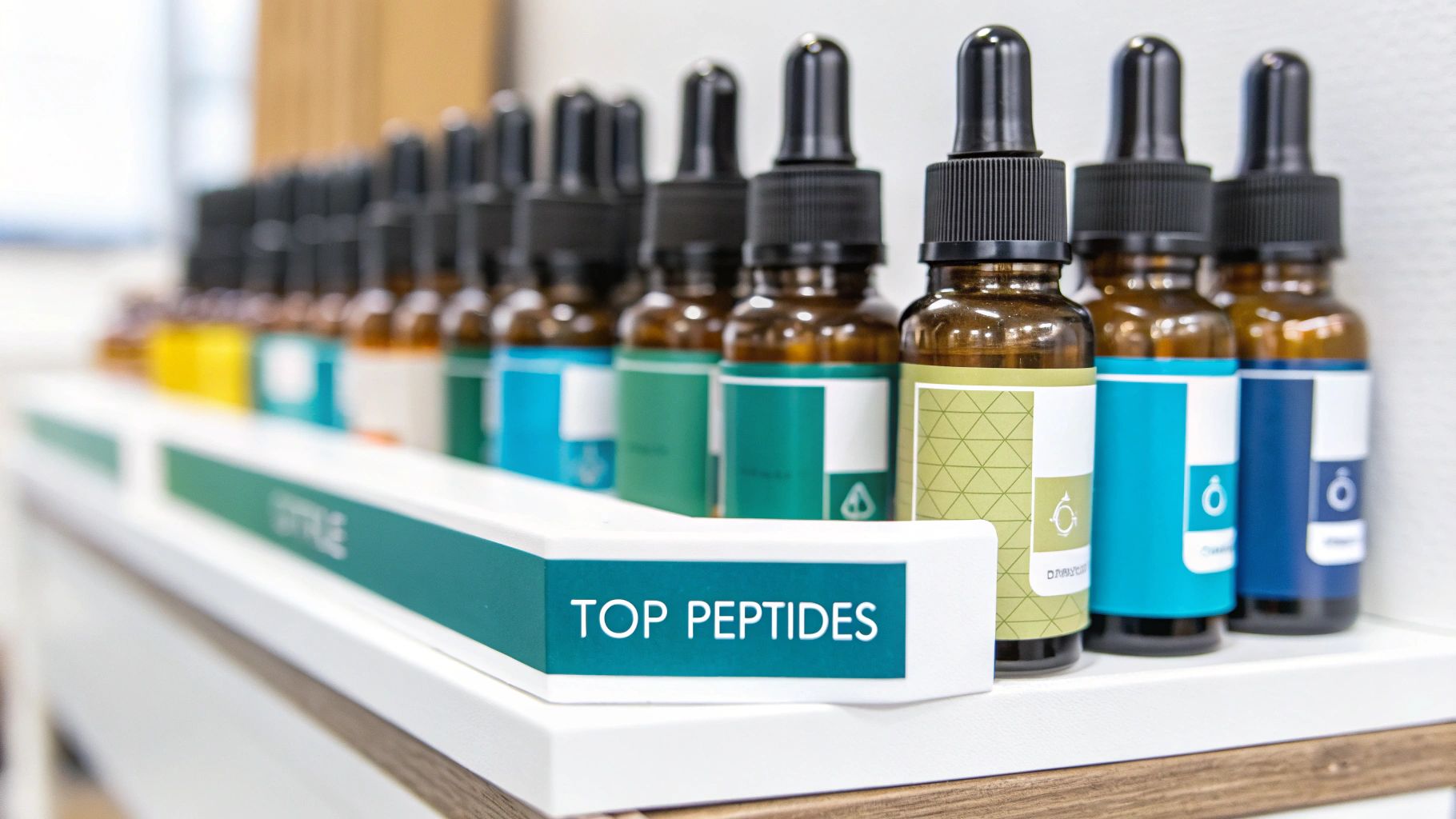
Now that you know how the different types of peptides operate, it's time to meet the industry's heavy hitters. Certain peptides have rightfully earned their celebrity status by consistently delivering results in high-quality, youth-promoting formulas. These are the names you’ll want to look for on an ingredient label.
Think of it like building a dream team for your skincare goals. Each peptide brings a very specific skill to the table, and knowing what each one does best helps you pick the right players for your team. Let's get to know some of the best peptides for anti aging and what makes them so remarkable.
Argireline for Expression Lines
First up is Argireline, the trademarked name for Acetyl Hexapeptide-8. This neuropeptide shot to fame for its unique way of addressing dynamic wrinkles—those pesky lines that show up from years of smiling, squinting, and laughing. It helps soften the look of these expression lines, leaving your skin looking smoother and more relaxed.
Picture folding a piece of paper over and over in the same spot; eventually, a permanent crease appears. Argireline works to make those "creases" on your skin less noticeable, especially around the eyes (crow's feet) and on the forehead. This makes it a go-to ingredient for anyone wanting to tackle the visible signs of a life full of expression.
Matrixyl 3000 for Firmness and Texture
Next, we have Matrixyl 3000, a true icon in the signal peptide world. It isn't just one peptide—it's a powerhouse combo of two: Palmitoyl Tripeptide-1 and Palmitoyl Tetrapeptide-7. They work together beautifully to support your skin's underlying structure, which is absolutely essential for keeping it looking firm and resilient.
This dynamic duo helps improve the appearance of skin texture and supports elasticity. If Argireline is the specialist for expression lines, you can think of Matrixyl 3000 as the master architect, focused on maintaining the overall structural integrity and youthful bounce of your complexion. Seeing it in a formula is a great sign that a product is serious about promoting visible firmness.
By supporting the skin’s natural protein maintenance, Matrixyl 3000 helps preserve a smoother, more supple appearance. It is one of the most well-regarded ingredients for anyone concerned with the loss of firmness that can occur over time.
Copper Peptides for Radiance and Vitality
Copper peptides, often listed as GHK-Cu, are another cornerstone of sophisticated skincare. As carrier peptides, their main job is to deliver and stabilize copper, a trace mineral that's vital for many of the skin's natural processes. This delivery system is key to maintaining overall skin appearance and achieving a vibrant, healthy glow.
These peptides are multitaskers, known for a wide range of benefits. They help even out skin tone, improve texture, and support the skin's natural protective barrier. This well-rounded approach makes copper peptides a fantastic choice for anyone hoping to achieve a more luminous and healthy-looking complexion.
Here’s a quick breakdown of these three peptide powerhouses to help you see their key roles at a glance.
| Peptide | Primary Focus | Ideal For |
|---|---|---|
| Argireline | Minimizing the look of expression lines | Addressing crow's feet and forehead lines |
| Matrixyl 3000 | Improving the appearance of firmness and texture | Supporting overall skin structure and resilience |
| Copper Peptides | Promoting overall radiance and vitality | Enhancing skin tone and luminosity |
Choosing the best peptides really comes down to what you want to achieve. Are you focused on softening smile lines, boosting overall firmness, or just getting a brighter glow? When you understand what each of these top-tier ingredients does best, you can make smarter choices when buying products or even when creating your own custom skincare formulas.
How to Add Peptides to Your Skincare Routine
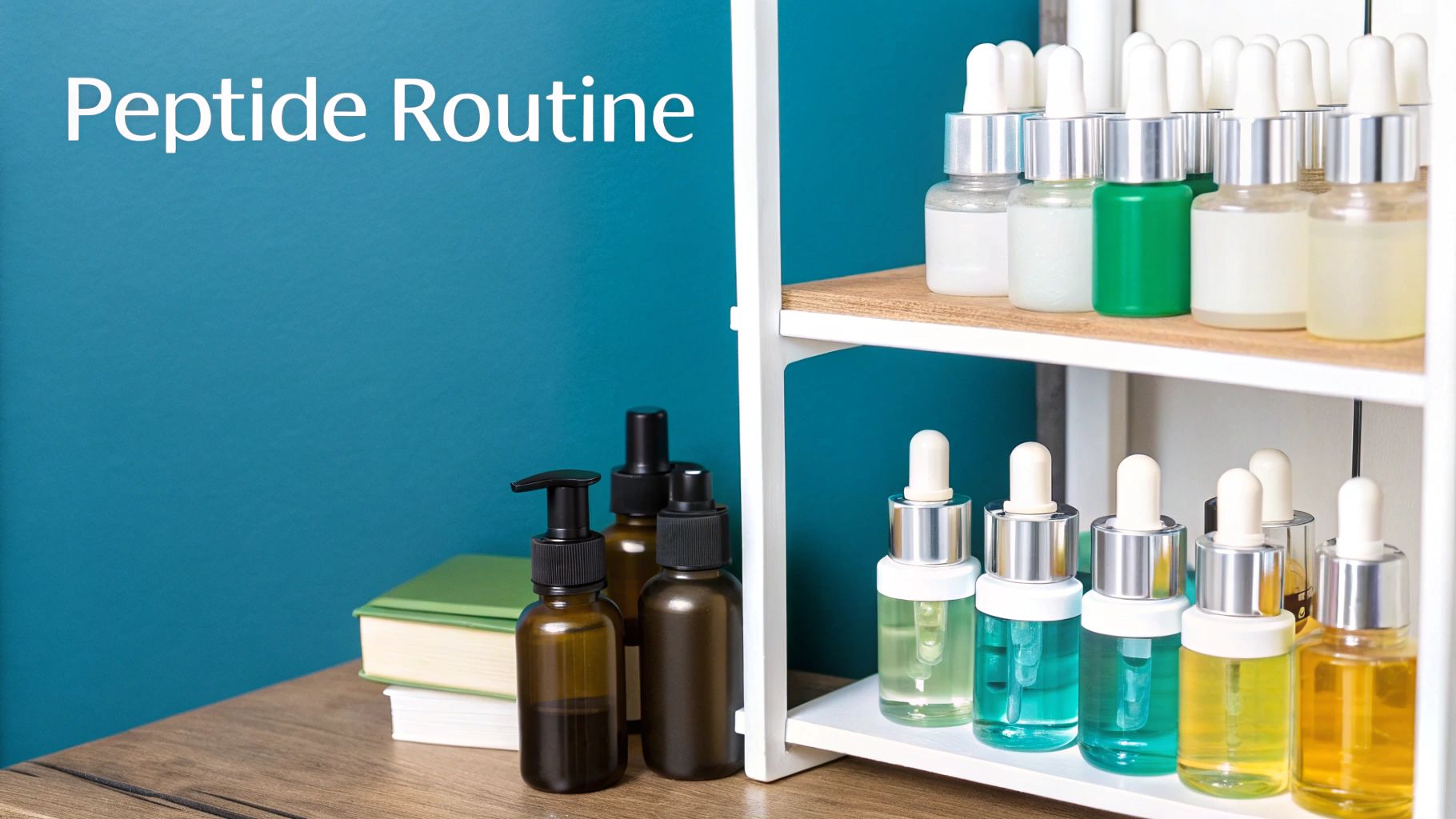
Knowing the best peptides for anti-aging is a great first step, but how you actually use them is what truly makes a difference. Nailing your application is the key to unlocking their full potential and getting that visibly youthful look we're all after.
For peptides to do their job, they need time to sink in and "talk" to your skin cells. This is exactly why leave-on products like serums and moisturizers are your best bet—they're far more effective than rinse-off cleansers that are gone in sixty seconds. Serums, in particular, are fantastic for delivering peptides because their lightweight formulas are designed to absorb deeply and get to work.
There's a huge demand for smarter peptide delivery systems, and the market shows it. It's projected to leap from USD 2,106.3 million to a whopping USD 7,200.5 million in just a decade. This boom is all about creating powerful leave-on products that deliver real results.
Layering Your Products for Maximum Impact
The order you apply your skincare isn't just a suggestion; it's crucial. Getting the sequence right ensures every ingredient can penetrate your skin properly without being blocked by a thicker product. The golden rule is simple: apply your products from the thinnest consistency to the thickest.
Here’s a simple layering guide to get you started:
- Cleanser: Always start with a clean canvas.
- Toner: This preps your skin and balances its pH.
- Peptide Serum: Apply your peptide product right after toning for the best absorption. This is the perfect time to add a targeted serum booster to supercharge your results. Our guide on how to add a serum booster can help you customize your routine like a pro.
- Other Actives: Layer on any other serums or treatments you're using.
- Moisturizer: This step is essential to lock in all that goodness.
- SPF (AM Routine): Never, ever skip protecting your skin from the sun.
Peptides and Other Active Ingredients
One of the most common questions we get is how to mix peptides with other skincare powerhouses like vitamin C or retinoids. The good news? Most peptides are total team players and get along well with others, but there are a few things to keep in mind.
When pairing peptides with a pure vitamin C (L-Ascorbic Acid), it’s often best to use them at different times—vitamin C in the morning for its antioxidant properties, and peptides at night to support skin. However, many modern vitamin C derivatives are much more stable and can be layered with peptides without any issue.
If you're using retinoids, apply the retinoid first, give it a moment to fully absorb, and then follow up with your peptide moisturizer or cream. This simple trick ensures both ingredients can work effectively without stepping on each other's toes.
Finally, remember that consistency is everything. Peptides support your skin’s natural processes over time, so you won’t see changes overnight. Stick with your routine for at least four to six weeks to start noticing a real improvement in your skin’s texture and firmness.
Creating Your Own Custom Peptide Formulas
Ready to take control of your skincare? Diving into the world of DIY formulas is an incredibly empowering next step for anyone passionate about their routine. Crafting your own peptide serums from scratch is more than just a fun project—it's about total customization. You're in the driver's seat, deciding exactly which of the best peptides for anti aging to include and at what strength, creating something truly unique to your skin's needs.
This hands-on approach allows you to tackle your specific concerns with precision. Want to soften the look of expression lines? Boost the appearance of firmness? Or maybe achieve a brighter, more even-toned complexion? You can build a formula that does exactly that. Plus, you’ll know your creation is as fresh and potent as it can possibly be.
This trend isn't just a niche hobby; it's part of a massive movement. The Global Anti-Aging Ingredients Market was recently valued at a staggering USD 10.59 billion. Experts project that number will climb as more people learn how to effectively support their skin.
A Simple DIY Peptide Serum Recipe
Don't be intimidated—mixing up a high-performance serum is far more straightforward than you might imagine. With the right ingredients and a few simple tools, you can whip up a powerful, fresh formula in just a few minutes. This recipe is a fantastic starting point for beginners, designed to support a visibly youthful look.
The easiest way to get started is with an all-in-one kit. Our Make Your Own Custom Super Serum Kit takes all the guesswork out of the equation. It provides everything you need, so you can skip sourcing individual ingredients and start with a proven, effective base.
If you're sourcing ingredients yourself, here's what a simple but effective serum recipe typically includes:
- Distilled Water: This will be the foundation, or base, of your serum.
- Hyaluronic Acid Powder: This hero ingredient creates that lush, hydrating gel texture and helps plump the skin’s appearance.
- Your Chosen Peptides: Pick one or create a power couple! Popular choices include Matrixyl 3000 or Argireline.
- A Preservative: This is a non-negotiable step to keep your serum fresh and free from unwanted contaminants.
- A Small Beaker and Stirring Rod: For mixing your ingredients with precision.
- An Airless Pump Bottle: The best way to store your creation, protecting it from degrading air and light.
The real beauty of a custom formula is the control it gives you. You can tweak peptide concentrations, combine different actives, and create a product that adapts to your skin's ever-changing needs—something you just can't get from an off-the-shelf product.
By making your own serums, you're not just ensuring maximum potency; you're gaining a much deeper connection to and understanding of what you put on your skin. It's a mindful approach to beauty that is both incredibly rewarding and highly effective, helping you build a routine that is 100% your own.
Your Top Questions About Anti-Aging Peptides, Answered
As you start digging into the world of peptides, you're bound to have some questions. It's totally normal. Getting the hang of how to use these powerful ingredients will give you the confidence to build a routine that gets real results. Let's tackle some of the most common things people ask.
One of the first questions is always about mixing different peptide products. The short answer? Yes, you absolutely can! In fact, many of the best peptides for anti-aging work even better together, creating a powerful team effect. For example, pairing a signal peptide like Matrixyl 3000 with a neuropeptide like Argireline is a fantastic strategy to tackle both firmness and those pesky expression lines at the same time.
When Should I Start Using Peptides?
There's no magic age to start adding peptides to your routine. Most of us start seeing the first little changes in our skin's appearance in our late 20s or early 30s. This is when our natural protein production starts to pump the brakes a bit. Introducing peptides at this point is a brilliant proactive move to support your skin’s youthful look.
But here’s the good news: it's never too late to get started. Peptides can deliver visible benefits at any age by helping to support the skin's underlying structure and promoting a smoother, more resilient appearance. The real key isn't when you start—it's staying consistent.
Can I Use Peptides With My Other Skincare Ingredients?
Another hot topic is how peptides play with other ingredients in your skincare lineup. For the most part, peptides are incredibly easygoing and get along great with most other skincare favorites.
A common myth is that peptides don't mix well with vitamin C or retinol. The truth is, while some very unstable forms of vitamin C (like L-Ascorbic Acid) could potentially cause issues, most modern, stable C derivatives are perfectly fine to use with peptides. Similarly, layering a peptide cream after your retinoid is a great way to support your skin.
Here’s a quick guide to some powerhouse peptide pairings:
- Hyaluronic Acid: This combo is a hydration dream team. Hyaluronic acid pulls moisture into the skin, while peptides work on improving the look of firmness. The result is a plump, beautifully supple complexion.
- Niacinamide: This do-it-all ingredient helps support a healthy skin barrier, which creates the perfect environment for your peptides to get to work more effectively.
- Antioxidants: Ingredients like Vitamin E and Ferulic Acid are your skin's bodyguards, helping to defend it from daily environmental stressors. This perfectly complements the supportive action of peptides.
By keeping these simple guidelines in mind, you can confidently weave the best peptides into your current routine. It’s all about creating a personalized approach to help you maintain a radiant, youthful look for years to come.
Ready to create your own potent, personalized skincare? Explore our premium selection of peptides and lotion-making supplies at Skin Perfection and start crafting the custom formulas your skin deserves. Discover everything you need at our online store.


